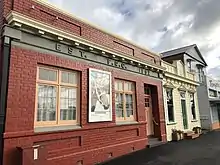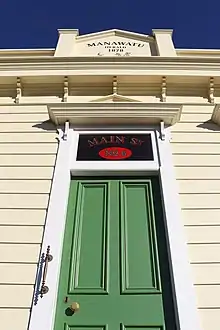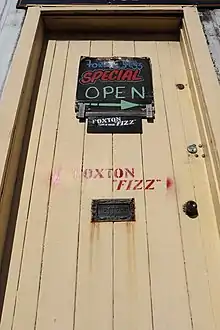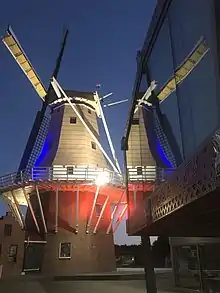Foxton, New Zealand
Foxton is a town in the Manawatū-Whanganui region of New Zealand - on the lower west coast of the North Island, in the Horowhenua district, 30 km (19 mi) southwest of Palmerston North and just north of Levin. The town is located close to the banks of the Manawatu River. It is situated on State Highway 1, roughly in the middle between Tongariro National Park and Wellington.
Foxton
Te Awahou (Māori) | |
|---|---|
Town | |
 Te Awahou Riverside Cultural Park and Water Tower | |
 Foxton | |
| Coordinates: 40°28′18″S 175°17′09″E | |
| Country | New Zealand |
| Region | Manawatū-Whanganui region |
| Territorial authority | Horowhenua District |
| Named for | William Fox |
| Electorate | Otaki |
| Government | |
| • MP | Nathan Guy |
| • Mayor | Bernie Wanden |
| Population (June 2020)[1] | |
| • Total | 3,310 |
| Postcode | 4814 |
| Area code(s) | 06 |




The slightly smaller coastal settlement of Foxton Beach is considered part of Foxton, and is located 6 km (4 mi) to the west, on the Tasman Sea coastline.
The 2013 New Zealand census recorded a resident population of 2,643. Since then the population has increased to over 3,100.[2]
Foxton has preserved its heritage[3] - both Maori and Pakeha - through its parks, heritage buildings and four museums. The Manawatu River Loop and estuary creates an environment that features walkways and Ramsar wetlands with 93 species of birds.[4]
Changing identity
The 50 or so flax mills that once operated in Foxton's vicinity slowly disappeared before WWII, while the Feltex carpet factory closed in 2008,[5] causing unemployment. What was once an industrious flax industry town,[6] had to reinvent itself.
These days, Foxton is trying to create a new local economy, by attracting visitors from throughout the region.[7] Several cafés[8] intersperse the boutique shops on Main Street.[9] A Cultural Park includes a Dutch windmill, a Maori carving workshop and the Flax Stripper Museum.[10] De Molen[11] hosts some 45,000 customers p.a. - while the multi-cultural community and visitor hub Te Awahou Nieuwe Stroom,[12] attracts some 150,000 users through its doors annually.
As the centre piece of the Cultural Park, the Te Awahou Nieuwe Stroom facility was awarded a top 'excellence' museum award in 2018.[13] The Piriharakeke[14] and Oranjehof[15] museums, a gallery, and exhibitions enable visitors to reflect on their own heritage and family’s roots. The multi-cultural and multi-lingual Te Awahou Nieuwe Stroom reflects diversity, and offers learning spaces through its library, heritage room and children's area with educational toys.
Foxton Beach caters to those interested in active life-style pursuits. The award-winning Pump Track[16] lets bikes and a skate-boards speed around a circuit with berms and 'rollers' (mounds), that the riders use (instead of pedalling) to gather velocity and keep momentum.
According to the Department of Conservation: "The diversity and number of wading and shore birds that visit the Manawatu Estuary make it one of the best bird watching spots in the country.".[17] And Foxton Beach is a popular swimming and fishing spot, that is patrolled in the weekends and public holidays in summer by the Foxton Surf Life Saving Club.[18]
Origins
The first inhabitants of the Manawatu area were Māori who probably arrived in the thirteenth or fourteenth century.[19] Compared to other parts of the North Island the district was sparsely populated, but there was a major marae at Matakarapa, across the river from Te Awahou (now Foxton) as well as kāinga (villages) and pā (fortified villages) along much of the river.[20] A number of tribes have occupied the area; the Rangitāne had replaced the Ngāti Ara and the Ngāti Mamoe by the 1800s and were in their turn invaded by the Ngāti Toa and allies so that in the 1840s the site of Te Awahou (which was to become Foxton) was occupied by the Ngāti Ngarongo and Ngati Takihiku under the leadership of Ihakara Tukumaru.[20]
Foxton is the oldest European settlement in the southern Manawatu, although it was not the first. The original white settlement was Paiaka to the east, closer to the present town of Shannon in 1844.[19] When Paiaka was largely destroyed by an earthquake in 1855 the settlers moved downstream to Te Awahou,[19] which was named "Foxton" from 1866.[21][22] In the early years of European settlement it was an important trading post and shipping port as the sea was the easiest way to transport goods and people to the Manawatu. The Manawatu River was then the main access to the rich hinterland. The west coast of the lower North Island is not naturally supplied with harbours and the Foxton harbour had a dangerous bar at the river mouth. As the only real harbour between Whanganui and Wellington it was used anyway.
History
Foxton was named after Sir William Fox, and has a history of flax stripping, which was used to make wool packs, matting and rope. Other industries associated with the town have included clothing manufacturing and sawmilling. The town is known for producing the soda drink Foxton Fizz,[23] although the products are now made in Putaruru.[24]
Early on, Foxton became a thriving regional centre, and with that status came a newspaper - the Manawatu Herald (est. in 1878).
It was only with the advent of the Palmerston North-Wellington railway that Palmerston North began to overtake it as the most important centre in the Manawatu. The central government had originally proposed that Foxton was to be on the route of the main line from Wellington to Auckland via Palmerston North, and a tramway linking Foxton and Palmerston North was upgraded into the Foxton Branch railway in the 1870s. However, due to government delays in extending the line further south, a group of Wellingtonian businessmen established the Wellington and Manawatu Railway (WMR), which announced in February 1881 that the "West Coast" line would run to Longburn, bypassing Foxton. This was a shorter and more direct route to Napier and Auckland, and avoided "unproductive country".[25]
When this line opened in 1886, Foxton's status as a port slipped, and this position deteriorated further when the WMR was incorporated into the government's national rail network in 1908. The branch railway closed in 1959, leaving only road access to the town.[26]
Flax Booms
The local Flax Stripper Museum tells the history of the once thriving flax industry, and claims Foxton as the Flax Capital of New Zealand.
NZ Flax (Phormium tenax) played a major role in Foxton's development; indeed Foxton, rather than being a "gold town" or "coal town" was indisputably a "flax town", sending their product overseas to be used worldwide as a substitute for manila.
The first traders at Paiaka and Shannon traded mostly for flax from the Maori, which was sent to Sydney.[19] The first of the flax booms began in 1869, lasting for four years during which 22,000 tonnes of fibre passed through Foxton's port.[27] The late 1880s saw a short-lived flax boom that briefly allowed Foxton to once again grow and function as a bustling port.[20]
A third flax boom, begun in 1898, was the most lasting and saw another increase in shipping, with over 10 steamers making regular visits. In 1903 the Moutoa Estate was developed as the main supply of flax.[20] By 1908 problems with river silting and bar strandings meant that coastal shipping was avoiding Foxton. By 1916 there were only two ships coming into the port[20] but in that year 97,000 bales of flax were shipped out from Foxton.[27]
The Whirokino Cut
Deforestation of the inland Manawatu District in the late nineteenth century meant increased flooding and led to the creation of stopbanks, floodgates, and the Whirokino Cut.[20] Completed in 1943 as part of the Lower Manawatu Flood Control Scheme, it was intended as a spillway but an unexpected flood broke through the upper end and diverted the river down the spillway, cutting off the Foxton loop of the river and causing great outcry at the time.[28] The Ministry of Works said this was unintentional, but some residents felt it was done purposefully. The Foxton Loop now only has a tidal flow and is not connected to the river at its top end, the upper end of the Loop having silted up during a flood in 1953.[29]
Though the Whirokino Cut is sometimes claimed as the reason Foxton failed to operate as a port, the dangerous bar and persistent silting were already providing problems and by the time the Cut was in place most shipping was already avoiding Foxton – it had already ceased to function as a port as early as 1942.[20]

What always has remained though, is Foxton's unique natural environment. The nearby Foxton Beach offers wetlands of international significance with godwits and multiple species of other rare birdlife, and a beach with plenty of surf, swimmers and fishermen and women.
Heritage
Foxton is a heritage town in its own right. Te Awahou Nieuwe Stroom and the Cultural Park - with its Dutch windmill De Molen, the Whare Manaaki carving workshop and the Flax Stripper Museum - are located in the centre of town. The fully restored BNZ building on Main Street, and the oldest cottage in the region 'Nye Cottage' on Harbour Street are both within view of the Park. The 1918 Foxton Fizz factory can be visited, and the MAVTech Museum provides a fascinating overview of the development of audiovisual technology during the last century. The exhibition is placed within an authentic, restored movie theatre that traces its origins back to 1911 when it first was built as a Coronation Hall. Next to the MAVTech Museum is the Foxton Courthouse building which houses the Foxton Museum. This building is currently closed due to it being an earthquake risk, with restoration plans being developed.[30] All are within a few minutes walk along Main Street with its many heritage buildings.
Climate
The area is sand country with a temperate climate, average monthly temperatures ranging from 8 °C (July) to 17.4 °C (January), with a minimum/maximum of −4 °C to 27 °C. Foxton has an average of about 2,000 sunshine hours a year, and average precipitation of about 900 mm annually.[31] The prevailing winds in the area are west-northwest and have driven the sand back from the coast to create the most extensive transgressive sand dune system in New Zealand.[32]
Transport
SH1 runs through Foxton. The town is served by three InterCity buses a day[33] and a commuter bus runs to Palmerston North at 7:05 am, returning at 5:20 pm. There is also a shoppers' bus to Levin on Fridays.[34]
De Molen Windmill

In 2003, a full size replica of a Dutch windmill, called De Molen was completed and opened. This working Stellingmolen windmill produces stone-ground flour, which can be purchased inside the mill's Dutch Deli. Visitors can climb up three floors, to witness the wooden mechanical workings of the mill in action - examples of traditional Dutch 17th Century engineering. The miller sets the blades in motion on windy days, and is available for tours to explain the history of milling, or for a more casual conversation.
Education
Manawatū College is a co-educational state secondary school,[35][36] with a roll of 290 as of March 2020.[37]
Foxton has two co-educational state primary schools for Year 1 to 8 students: Foxton School,[38][39] with a roll of 80,.[40] and Coley Street School,[41][42] with a roll of 219.[43]
St Mary's School is a co-educational state-integrated Catholic primary school for Year 1 to 8 students,[44][45] with a roll of 27.[46]
References
| Wikimedia Commons has media related to Foxton, New Zealand. |
- "Population estimate tables - NZ.Stat". Statistics New Zealand. Retrieved 22 October 2020.
- 2013 Census QuickStats about a place : Foxton
- https://horowhenua.kete.net.nz/item/ee164ef3-0b95-41e2-a845-a78417d1744b
- https://www.wetlandtrust.org.nz/get-involved/ramsar-wetlands/manawatu-estuary/
- https://www.newshub.co.nz/nznews/80-workers-lose-their-jobs-as-foxton-factory-closes-2008080119
- https://teara.govt.nz/en/interactive/35278/roadside-stories-foxton-and-flax
- http://enroute.nz/foxton/
- https://www.tripadvisor.co.nz/Restaurants-g1048041-c8-Foxton_Manawatu_Wanganui_Region_North_Island.html
- http://www.foxtonandthebeach.co.nz/shop/
- "Flax Stripper Museum". NZ Museums.
- "de Molen". The Windmill Trust.
- "Te Awahou Riverside Cultural Park".
- "Te Awahou Nieuwe Stroom wins the Museum Project Excellence Award". Bossley Architects. 21 May 2018.
- "Piriharakeke Generation Inspiration Centre". Te Awahou Riverside Cultural Park.
- "Oranjehof - Dutch Connection Centre". Te Awahou Riverside Cultural Park.
- https://nzila.co.nz/showcase/foxton-beach-pump-track
- https://www.doc.govt.nz/parks-and-recreation/places-to-go/manawatu-whanganui/places/manawatu-estuary/
- https://www.surflifesaving.org.nz/organisation/find-a-club/find-a-sls-club-in-nz/foxton-slsc
- Hannigan, J.W.; Barnes, K. 1982. History of the Manawatu River and the Manawatu Catchment Board. Report No. 42. Manawatu Catchment Board, Palmerston North, New Zealand. 25 pp.
- Hunt, A.N. (Ed) 1987. Foxton 1888–1988. The first 100 years. Foxton Borough Council, Levin, New Zealand. 270 pp.
- "Page 4 Advertisements Column 1 (Evening Post, 1866-09-20)". paperspast.natlib.govt.nz. Retrieved 17 August 2018.
- "A walk through historic Foxton – Part 2". Kete Horowhenua.
- Fizzing for return to Foxton
- Foxton Fizz nabs Z contract
- Cassells, K R (Ken) (1994). Uncommon Carrier – The History of the Wellington & Manawatu Railway Company, 1882–1908. Wellington: New Zealand Railway and Locomotive Society. pp. 20, 22. ISBN 0908573634.
- Malcolm McKinnon. Manawatū and Horowhenua places – Foxton and the coast, Te Ara – the Encyclopedia of New Zealand. Wellington: Ministry for Culture and Heritage. Updated 2 March 2009.
- Esler, A.E. 1978. Botany of the Manawatu district, New Zealand. Government Printer, Wellington.
- Hunt, A.N. 1968. Foxton – A small town in the Manawatu. MA Thesis, Massey University http://hdl.handle.net/10179/14159 .
- Council/Cncl 26 May 09/09-80 Manawatu River-Foxton Loop.pdf, MANAWATU RIVER – FOXTON LOOP, Horizons Regional Council, 26 May 2009.
- Moore, Rachel (11 February 2020). "More time sought for Foxton Courthouse Museum sale". Manawatū Standard. Retrieved 27 April 2020.
- 2. New Zealand Meteorological Service. 1983. Summaries of climatological observations to 1980. New Zealand Meteorological Service Miscellaneous Publication 177.
- Muckersie, C.; Shepherd, M.J. 1995. Dune phases as time-transgressive phenomena, Manawatu, New Zealand. Quaternary International 26, 61–67.
- "Search Results". www.intercity.co.nz. Retrieved 22 August 2018.
- "Did you know Horizons Regional Council provides three public bus services in the Horowhenua District?" (PDF). 15 July 2018.
- "Manawatu College Official School Website". manawatucollege.school.nz.
- "Manawatu College Ministry of Education School Profile". educationcounts.govt.nz. Ministry of Education.
- "Manawatu College Education Review Office Report". ero.govt.nz. Education Review Office.
- "Foxton School Official School Website". foxton.school.nz.
- "Foxton School Ministry of Education School Profile". educationcounts.govt.nz. Ministry of Education.
- "Foxton School Education Review Office Report". ero.govt.nz. Education Review Office.
- "Coley Street School Official School Website". coleystreet.school.nz.
- "Coley Street School Ministry of Education School Profile". educationcounts.govt.nz. Ministry of Education.
- "Coley Street School Education Review Office Report". ero.govt.nz. Education Review Office.
- "St Mary's School Official School Website". stmarysfoxton.school.nz.
- "St Mary's School Ministry of Education School Profile". educationcounts.govt.nz. Ministry of Education.
- "St Mary's School Education Review Office Report". ero.govt.nz. Education Review Office.